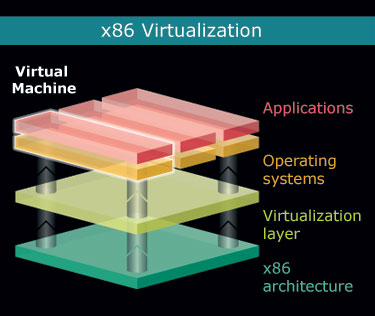 Virtualization, the technology that found it home for innovation at IBM mainframes with a totally different purpose has now become an integral part of enterprise serving some other benefits. Virtualization is making data centers more flexible and efficient, but the technology is also raising new challenges, IT managers say.
Virtualization, the technology that found it home for innovation at IBM mainframes with a totally different purpose has now become an integral part of enterprise serving some other benefits. Virtualization is making data centers more flexible and efficient, but the technology is also raising new challenges, IT managers say.
Consolidating onto fewer physical servers is one of the technology’s key benefits but there are some tradeoffs here. The cooling needs of a virtualized server are quite different than the needs of a server running only one application.
With virtualization increasing CPU utilization to 70-80%, “that generates a lot more heat,” says Turner, director of networks and systems at Brandeis. “If you walk behind the racks of virtualized servers, the heat is just pouring out of those guys. … We’re seeing heat dump into these rooms like never before.”
Using VMware and Xen, Brandeis has virtualized nearly all of its servers over the last couple of years, reducing its total number of physical servers from about 120 to less than 30 today. But Turner says his power use has increased on the whole because virtualization has made it easy to spin up many new applications that he didn’t run when Brandeis used only physical resources.
Also contributing to the power crunch is Brandeis’s use of a high-performance computing cluster and Moore’s law of increasing processor speeds. Brandeis has managed growing power needs by increasing the size of uninterruptable power supplies, says Turner, who specified using APC’s Symmetra for its scalability.
“We’re having to adapt the data center to new demands that in the past just weren’t there,” Turner says.
Ultimately, the goal is to examine usage over time and power down unused nodes, while more intelligently managing live migration capabilities, he says.
Virtualization has improved development environment and made the provisioning of new servers simpler and faster, but not every workload is appropriate for the technology.
“Applications that require a lot of processing power are not good candidates for virtualization.”
Storage-area network technology is also just starting to catch up with the realities of virtualization, with the number of required storage volumes growing as IT packs more virtual machines onto fewer physical boxes, Turner says.
But virtualization will be essential at State Street as it considers building a private cloud network. While the details and implementation date have not been figured out, Meyer says her team is hoping to harness virtualization, Web services and other technologies to build a network that lets users request new services and get them quickly, without having to worry about buying a server or setting up storage.
They can request a service and the service will be there. That’s the idea, The services that users require most often will be easily available to them through the [private] cloud.
State Street is looking at public cloud services but is leaning toward keeping critical data center operations internal. “We’re evaluating the security implications [of public cloud services],” she says. “I am not sure the security is there for our business.”
At IT Roadmap, Meyer will talk generally about delivering IT services better, faster and more affordably. Despite being in a recession, IT can improve its operations and prepare for the future, she says.
“Crises produce opportunities,” she says. “We have a great opportunity ahead of us. This is the best time to position IT, because when the market comes back it will come back so fast that you have to be ready.”
loading...
loading...
